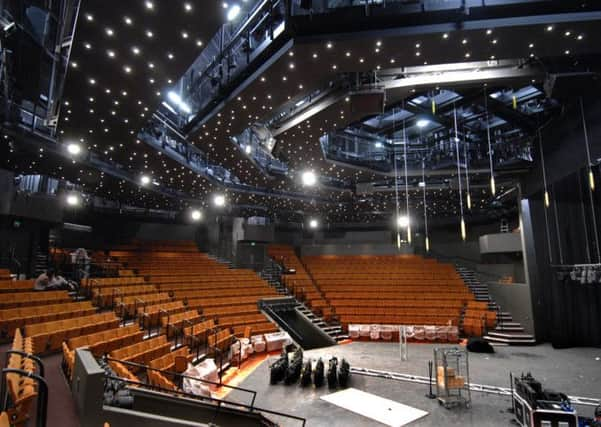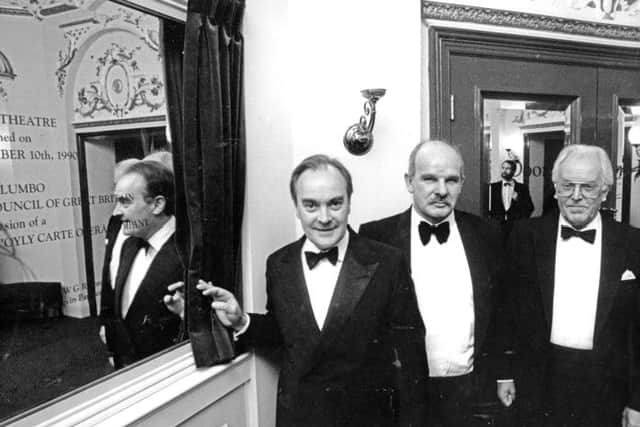Curtain up: Spotlight on theatreland


When Sheffield’s Lyceum Theatre reopened after its lavish renovation 20 years ago, crowds turned up for an open day and I met Mr Walter Gill, who had worked there as a stage hand in the 1940s.
He remembered the shows (“Maid of the Mountains was a bad one – a lot of heavy work, a lot of changes in it”). He remembered the actresses (“Margaret Lockwood stood out above the rest; a lovely lady. She had a big mole on the side of her cheek”).
Advertisement
Hide AdAdvertisement
Hide AdMost of all, though, he remembered a young comedian who appeared in a 1942 panto. The comedian had a thin face, wild black hair and a look of manic surprise. “He’s a funny man, but I never thought he’d go as far as he did,” said Mr Gill. “To me he hadn’t got the calibre that was necessary. He came on by leaps and bounds, though, afterwards.”


Leaps and bounds and tickling sticks and Diddymen, and an endless, joyous stream of gags that can go on and on so long that, the old joke goes, theatre managers hand him the keys to lock up when the show finally comes to an end in the early hours.
It was, Ken Dodd, and every word about the marathon shows is true. “Famed for his ‘all-nighters’,” says Roy Rogers, who once spent two summer seasons as his production manager. “He’s excruciatingly wonderful.”
More than 20 years on, and with a rucksack of props strapped to his back, Roy, former head of marketing and sales at the Sheffield Crucible, is co-leading a walking tour of the city’s theatreland, with Chris Reece, the Crucible’s former manager. They’re starting in Tudor Square, focal point of what’s sometimes claimed to be the biggest cluster of theatres outside London: five of them, including the Lyceum and the Crucible. Is the claim true, I wonder. Roy looks dubious but, the theatre’s nothing if it’s not about make-believe, is it? Launched a couple of years ago, these “walk and talk” tours – of theatres that exist and theatres that don’t – run twice a month, but this one is rather different. A two-dozen-strong group has been specially invited to, as Chris says, “find out how we can enhance our tours for people with hearing loss or visual impairment”. At the start, Roy and Chris take turns to hold a mobile phone that relays their commentary to a stenographer in Ireland. She types it onto a web page which guests with hearing loss can read on a tablet.
Advertisement
Hide AdAdvertisement
Hide AdAs Sandra Brasher, visually impaired and a regular theatre-goer, explains, some theatres offer live commentaries, picked up on headsets, describing what’s happening on stage.
The Crucible – here in front of us, with its name spelled out in letters almost as big as the famous Hollywood sign – seemed quite strange to many Sheffield theatre-goers when it opened in 1971. It was big, slightly daunting, shamelessly ambitious and potentially alienating, with all that concrete and all those radical angles and – heaven help us, Doris – a thrust stage.
Some Sheffielders concluded: “This place isn’t for the likes of us.” It didn’t help that the opening production was Ibsen’s long and puzzling Peer Gynt. After many ups and downs, however (and a lot of reassuring snooker), the Crucible is now an award-winning national asset.
Nudging its front doors and topped by a statue of Mercury, the dazzlingly handsome Lyceum – as Chris points out – hosted Sir Henry Irving’s farewell tour in 1905. He had his last full week on stage here, before moving on to Bradford, where he died at the Midland Hotel after a performance at the Theatre Royal.
Advertisement
Hide AdAdvertisement
Hide AdLater, there were pantos starring Harry Secombe and Morecambe and Wise, but the laughter subsided as the Lyceum became a bingo hall, closed, reopened briefly as a rock venue, was saved from demolition, and then magnificently restored, all cream and burgundy and gilded cherubs.
Our tour takes a turn around town, mostly looking at what’s not there any more. Here, opposite the Lyceum, was the Theatre Royal, where Edmund Kean and Sarah Siddons played: burned down in 1935. Here was the Empire Palace, with its domes and turrets: demolished in 1959 and now a utilitarian office block.
The Empire was, famously, a home of music hall and variety – George Robey, Florrie Forde, Marie Lloyd, top names. “It was very much a building people went to to forget their worries,” says Chris. Not for Florrie Forde it wasn’t. Heckled from the stalls in this world capital of cutlery, she shouted: “You know where you can stick your knives and forks, Sheffield!” and stormed off.
As the tour draws to a close, Roy reads out the damning judgment on theatre in general by a Victorian vicar, the Rev Thomas Best: “Inborn depravity means that the theatre audience is composed of beings who by the very fault and corruption of their nature are already inclined to evil!”
Advertisement
Hide AdAdvertisement
Hide AdOur final glimpse of the past is the site of the Playhouse, the cosy, clubby little theatre that was such a contrast to the Crucible. It had a comfortingly local atmosphere, a lot of ambition and offered a chance to see famous actors before they became famous: Patrick McGoohan, Keith Barron, Paul Eddington.
Ah yes... Paul Eddington. I once met him at a reception at the Lyceum. I told him how moved I’d been by his performance years earlier as the king in Alan Bennett’s The Madness of George III. One of the great nights in the theatre, I said, overwhelming, matchless. “That’s awfully kind of you,” he said. “But I think you’ll find that was my great friend Nigel Hawthorne.” What a gent.
Walk and Talk tours cost £5 per head. Contact 0114 268 3697 for dates and details.